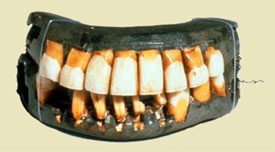Dental
Terminology and Dental Procedures
Visit any
dental office or clinic and more than likely you will hear dental teminology or dental procedures that you are not
familiar with. Don't worry you're not alone. Most patients, unless they have a background in dentistry, don't get the "tech talk" uttered by the staff of a dental office . So, as a 101 style education on the subject, here are a list of some of the more common
dental terms and what they mean.

Tooth
numbers – In dentistry we number teeth as a way to help us identify which tooth/teeth
we are talking about accurately and quickly.
Adults have 32 permanent teeth, sometimes called secondary teeth. Adult teeth are numbered 1 – 32. Tooth #1 is
your top right wisdom tooth. As you go towards the front of your mouth the next
one is tooth #2. Go all the way around
the top of the mouth, numbering each tooth in consecutive order as you go, to the
wisdom tooth on the top left and that is #16. Then we drop down to the lower
teeth, but this time we go left to right.
The lower bottom left wisdom tooth is #17 go all the way around, numbering
as you go, and to the lower bottom right and that is tooth #32. Baby teeth, or primary teeth, are lettered A –
T, and are lettered in the same rotation as permanent teeth.
Crown of
the tooth- this is the part of the tooth that is above the natural gum line.
Root of
the tooth – This is the part of the tooth that is below the gum line. Sometimes people have gum recession and will have
root exposure, but typically it is below the gum line.
Composite/resin
fillings – These are fillings that are tooth colored. Unlike amalgam fillings these bond to the
teeth and more aesthetically pleasing.
Amalgam
(silver-mercury) fillings that are made of metal. At one time these were a great option for
filling cavities, but today we have materials that are much safer and better
for our teeth and health.
Crowns –
This is a restoration that is used when there is not enough natural tooth structure
to support a filling or an inlay or onlay. Crowns cover the whole tooth. Your natural tooth is prepped in a way that
allows this restoration to sit on the tooth and cover it completely all the way
around all sides. These are typically made of porcelain, but can be made of
metal or porcelain fused to metal. Crowns are really "Old-School" - and are almost always less-optimal of a treatment option (they are more invasive - and don't last as long due to re-decay).
 |
| Inlays and Onlays |
Inlays/Onlays
– These are dental restorations that are used when the decay in the crown of
the tooth is too big to use a filling, but not large enough to warrant a
crown. They fit in the decayed area of
the tooth like a puzzle piece and, unlike (and better than) a crown, they are BONDED to the tooth.
Dental Bridge – a
fixed restoration that is used to replace a missing tooth. Bridges use the
adjacent teeth on each side of the missing tooth. Crowns are placed on each of the adjacent
teeth and a false tooth is bonded to these crowns, essentially creating a
bridge between the crowns.
 |
| dental bridge |
Root
Canal – is a procedure used to save a tooth from being removed. When the nerve inside the tooth becomes irreversibly
damaged or infected the only two options for treatment are extraction or root
canal. While root canals have a nasty reputation,
they really are as easy as getting a filling. Dentistry today has made great
strides in ensuring patient’s comfort.
During this procedure the dentist opens a small hole in the tooth then “painlessly”
removes the infected/damaged part of the tooth.
The tooth is then filled in with a material and restored with a
crown. This allows the patient to keep
their tooth, which is preferable to any replacement option.
 |
| Dental Implants |
Dental
implant – If you do have a missing tooth, this is my preferred replacement
option. This is the option that is most
like your natural tooth/teeth. It feels,
looks and functions like a natural tooth. A screw is placed in the bone below
the gum line, where the root of the tooth would have been. Then a crown made for the implant is placed on
top of the implant. It may sound painful,
but just as you can’t feel the roots of your teeth, you won’t feel the implant
either. There are many advantages to
this option. The biggest being it is
permanent! Also, with other tooth replacement options patients still lose bone
levels, with this option bone levels are maintained. Implants can be used to
support dentures or bridges as well.
If you
have any other dental terms you would like to have explained please leave a
comment and I will be happy to answer any and all questions! Adjacent teeth on both sides of where the
tooth/teeth are missing. Crowns are placed on the existing teeth on either side
of the missing tooth and a false tooth is bonded to these crowns where the
tooth is missing, essentially, making a “bridge” between two crowns.









